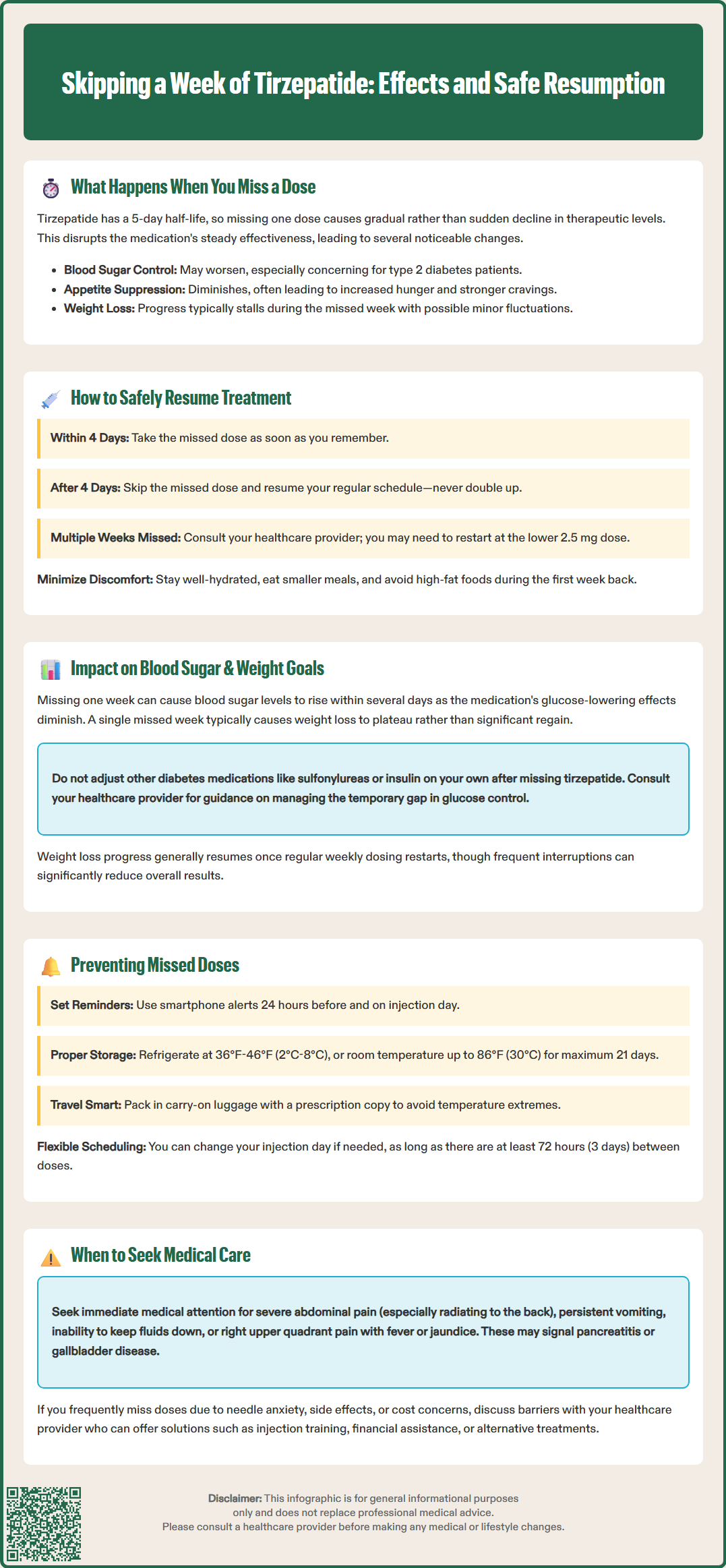LOSE WEIGHT WITH MEDICAL SUPPORT — BUILT FOR MEN
- Your personalised programme is built around medical care, not willpower.
- No generic diets. No guesswork.
- Just science-backed results and expert support.
Find out if you’re eligible

Skipping a week of tirzepatide—marketed as Mounjaro for type 2 diabetes and Zepbound for weight management—can temporarily disrupt blood sugar control and appetite regulation. This once-weekly injectable medication combines GIP and GLP-1 receptor agonist activity to manage glucose levels and support weight loss. When a dose is missed, therapeutic effects gradually decline due to the drug's five-day half-life. Understanding how to safely resume treatment and minimize clinical impact is essential for patients relying on tirzepatide for diabetes management or chronic weight control. FDA prescribing guidelines provide specific instructions for addressing missed doses and maintaining treatment continuity.
Quick Answer: Skipping a week of tirzepatide temporarily reduces blood sugar control and appetite suppression, but can be safely managed by resuming your regular schedule without doubling doses.
Tirzepatide is available as Mounjaro (for type 2 diabetes) and Zepbound (for chronic weight management), both containing the same active ingredient administered as a once-weekly subcutaneous injection. This medication combines glucose-dependent insulinotropic polypeptide (GIP) and glucagon-like peptide-1 (GLP-1) receptor agonist activity. Missing a scheduled dose can disrupt the medication's steady-state pharmacokinetics, though the clinical impact depends on how long the dose is delayed. The drug has a half-life of approximately five days, meaning therapeutic levels decline gradually rather than abruptly after a missed injection.
When you skip a week of tirzepatide, several physiological changes may occur. Blood glucose control may deteriorate as the medication's insulinotropic effects wane, particularly in patients with type 2 diabetes who rely on tirzepatide for glycemic management. The appetite-suppressing effects mediated through central nervous system pathways may also diminish, potentially leading to increased hunger and food intake. Some patients report changes in appetite and satiety, including increased cravings, larger portion sizes, and reduced fullness between meals.
The gastrointestinal effects of tirzepatide—including delayed gastric emptying—also reverse as drug levels fall. Some patients may experience changes in appetite that feel more pronounced than before treatment began. Weight loss momentum typically stalls during the missed week, and some patients may experience minor weight fluctuations.
It is important to note that missing a single dose does not constitute treatment failure or require restarting at a lower dose in most cases. However, the interruption does represent a temporary loss of therapeutic benefit that should be addressed promptly according to FDA-approved prescribing guidelines.
The FDA prescribing information for tirzepatide provides specific guidance for resuming treatment after a missed dose. If a dose is missed, administer the injection as soon as possible within 4 days after the missed scheduled administration. If more than 4 days have elapsed since the missed dose—which includes skipping an entire week—the FDA recommends skipping the missed dose entirely and administering the next dose on the regularly scheduled day. Patients should not double up or take extra doses to compensate for the missed injection, as this increases the risk of gastrointestinal adverse effects including nausea, vomiting, and diarrhea.
When changing your weekly injection day, ensure at least 72 hours (3 days) between doses. The regular weekly schedule should be maintained going forward, with injections administered on the same day each week.
For patients who have missed multiple consecutive doses or have been off tirzepatide for several weeks, consultation with the prescribing healthcare provider is essential before resuming treatment. Extended interruptions may warrant restarting at a lower dose to minimize gastrointestinal side effects, particularly if the patient had previously experienced significant nausea or vomiting during dose escalation. The standard titration schedule begins at 2.5 mg weekly for four weeks, then increases to 5 mg weekly, with further increases in 2.5 mg increments every four weeks as tolerated, up to a maximum of 15 mg weekly.
Patients should monitor for recurrence of side effects when resuming tirzepatide, especially gastrointestinal symptoms. Staying well-hydrated, eating smaller meals, and avoiding high-fat foods can help minimize discomfort during the first week back on medication. Seek immediate medical attention for severe or persistent abdominal pain (especially if radiating to the back), persistent vomiting, inability to keep fluids down, or right upper quadrant pain with fever or yellowing of the skin, which could indicate serious conditions such as pancreatitis or gallbladder disease.

Skipping a week of tirzepatide may affect both glycemic control and weight management outcomes, though the magnitude varies among individuals. In patients with type 2 diabetes, the medication's glucose-lowering effects may diminish as plasma concentrations fall below therapeutic thresholds. Clinical trials (SURPASS) have demonstrated that tirzepatide reduces hemoglobin A1c by 1.9% to 2.4% depending on dose, with much of this benefit attributable to enhanced glucose-dependent insulin secretion and suppressed glucagon release. When a dose is missed, fasting and postprandial glucose levels may rise within several days.
Patients using continuous glucose monitors may observe changes in glycemic patterns during the week following a missed injection. The American Diabetes Association Standards of Care recommend target fasting glucose of 80-130 mg/dL and postprandial readings below 180 mg/dL. Patients should contact their healthcare providers if glucose readings are persistently above their individualized targets. Those taking concurrent diabetes medications, particularly sulfonylureas or insulin, should not self-adjust these medications but should consult their healthcare providers, as the temporary loss of tirzepatide's glucose-lowering effect may require professional guidance.
Regarding weight loss, missing a single week typically results in a plateau rather than significant weight regain. The SURMOUNT-1 trial showed that tirzepatide produces dose-dependent weight reduction of 15% to 22.5% over 72 weeks in patients with obesity. This weight loss occurs through multiple mechanisms including reduced caloric intake, delayed gastric emptying, and possible effects on energy expenditure. When treatment is interrupted, the appetite-suppressing effects may fade within days, and patients might consume more calories than during active treatment.
Some patients may experience transient weight fluctuations during a missed week. The long-term impact on weight loss goals depends on how quickly treatment is resumed and whether the interruption leads to sustained changes in eating behaviors. Patients who miss multiple doses or experience frequent treatment interruptions may see less weight loss compared to those maintaining consistent weekly dosing. Weight loss momentum typically resumes once regular dosing is reestablished, though the interruption does represent lost time toward achieving target weight goals.
Adherence to weekly tirzepatide injections is crucial for optimizing therapeutic outcomes, and several practical strategies can help prevent missed doses. Setting a consistent injection day and time creates a routine that becomes habitual over time. Many patients find success choosing a day when their schedule is predictable—often weekends or a specific weekday evening—and setting smartphone reminders or calendar alerts 24 hours in advance and again on the injection day.
Medication management systems can significantly improve adherence. Store tirzepatide pens in the refrigerator between 36°F and 46°F (2°C to 8°C). If needed, the medication may be stored at room temperature not to exceed 86°F (30°C) for up to 21 days. Do not freeze tirzepatide and protect it from light. Keeping medication in a visible location in the refrigerator where it is encountered regularly serves as a visual reminder. Some patients use pill organizers or medication tracking apps that send notifications and allow logging of administered doses. Pharmacy-based reminder services, including text messages or automated calls when prescriptions are due for refill, provide an additional safety net. If permitted by your insurance and supply availability, maintaining a backup pen can help avoid missed doses due to supply interruptions or pharmacy delays.
The FDA prescribing information allows for schedule adjustments when necessary. You may change your weekly injection day as long as there are at least 72 hours (3 days) between doses. This flexibility accommodates travel, illness, or scheduling conflicts while maintaining therapeutic continuity. When planning travel, pack tirzepatide in carry-on luggage with a copy of the prescription, as checked baggage may expose the medication to temperature extremes that compromise efficacy. Always use proper sharps disposal for used pens and never share your medication with others.
For patients who frequently miss doses despite reminder systems, discussing barriers with healthcare providers is essential. Common obstacles include needle anxiety, side effect concerns, cost issues, or complex medication regimens. Healthcare teams can address these barriers through patient education, injection technique training, financial assistance programs, or regimen simplification. Some patients benefit from involving family members or caregivers in medication management, particularly when cognitive factors or busy schedules contribute to missed doses.
Patients should understand that consistent adherence yields superior outcomes compared to intermittent dosing. Studies of GLP-1 receptor agonists demonstrate that medication persistence correlates strongly with both glycemic control and weight loss success. Establishing tirzepatide as a non-negotiable part of weekly routine—similar to other essential health behaviors—helps maintain the commitment necessary for long-term success. If adherence challenges persist despite these strategies, healthcare providers may consider alternative treatment options with different dosing frequencies or delivery methods that better align with individual patient needs and preferences.
No, never double up on tirzepatide doses. If more than 4 days have passed since your missed dose, skip it entirely and resume your regular weekly schedule to avoid increased gastrointestinal side effects.
Missing a single week typically causes a weight loss plateau rather than significant regain. Appetite suppression may diminish temporarily, but weight loss momentum usually resumes once regular dosing is reestablished.
Tirzepatide has a half-life of approximately five days, meaning therapeutic levels decline gradually over several days to weeks after a missed injection rather than disappearing immediately.
All medical content on this blog is created using reputable, evidence-based sources and is regularly reviewed for accuracy and relevance. While we strive to keep our content current with the latest research and clinical guidelines, it is intended for general informational purposes only.
This content is not a substitute for professional medical advice, diagnosis, or treatment. Always consult a licensed healthcare provider with any medical questions or concerns. Use of this information is at your own risk, and we are not liable for any outcomes resulting from its use.